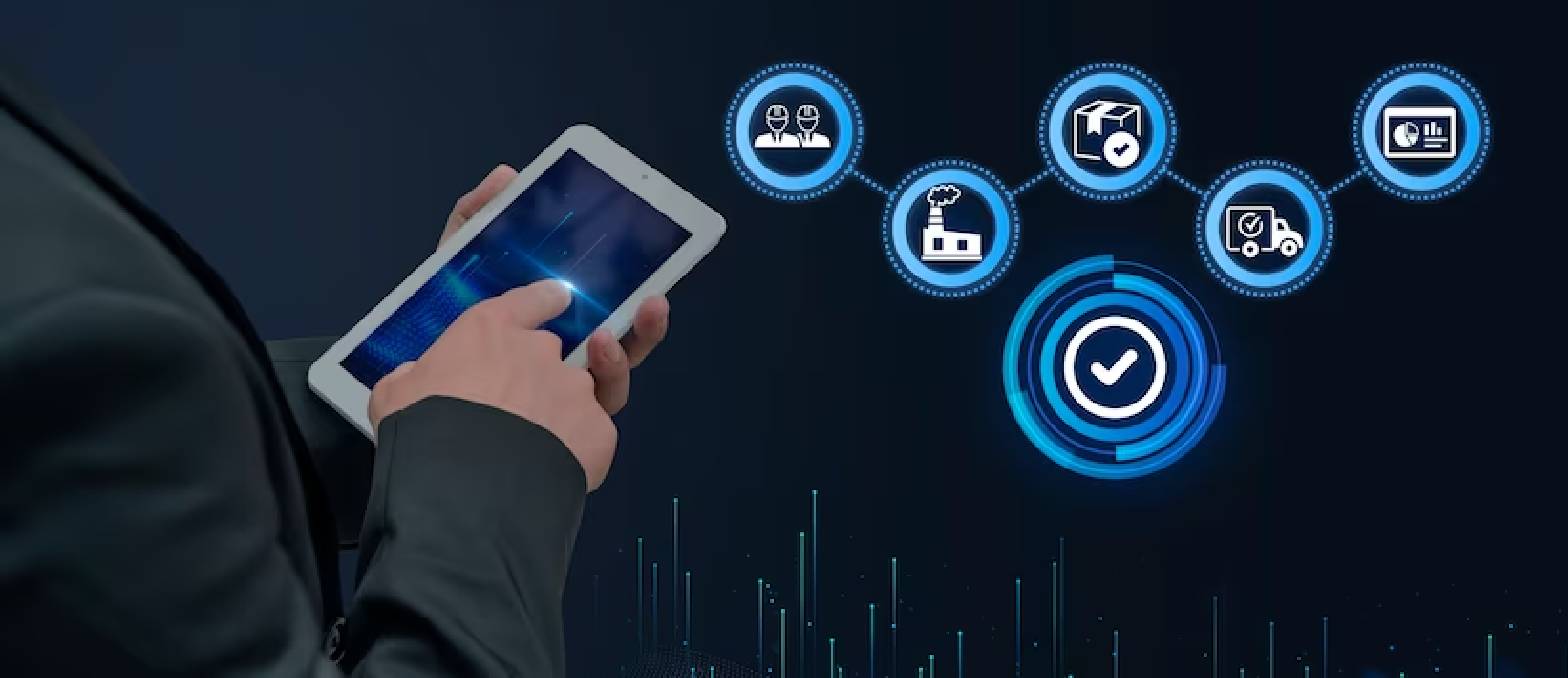Table of Contents
Enterprise Resource Planning (ERP) and electronic data interchange (EDI) are two of a kind. ERP solutions merge processes, oversee assets, and make a solitary rendition of truth for organization data. EDI services are the universally acknowledged tradition for sending electronic records inside and between organizations.
The connection between ERP and EDI originates from the way that archives shared through EDI, for example, purchase orders and solicitations, are made with ERP systems. Before moving them to their planned beneficiaries, an EDI platform changes over the reports into a pre-designed EDI standard, which can be grasped by the collector’s data in the executive’s system and handled independently.
Essentially, while an exchange partner shares data through EDI, the association’s EDI platform naturally interprets it into ERP-prepared data.
EDI & ERP Integration is becoming increasingly important for businesses to streamline their operations and remain competitive. The latest stats show that EDI ERP Integration can
- reduce costs by up to 50%,
- increase customer satisfaction by up to 30%,
- and improve efficiency by up to 25%.
EDI and ERP were once solitary meanings, freely shared and taken care of by various IT groups. In any case, because of automated advancements, EDI platforms that can promptly coordinate with existing ERP systems currently exist. By coordinating EDI with ERP, your endeavor can augment the utilization of the two improvements and accomplish critical advantages.
What is EDI?
The precise meaning of EDI is a standard electronic configuration that replaces paper-based records, for example, purchase recommendations or appeals with computerizing paper-based exchanges. Organizations can save time and dispose of exorbitant mistakes brought about by manual handling.
In EDI exchanges, data moves straightforwardly from a PC application in one organization to a PC application in another. EDI norms characterize the area and request of data in a record design. With this robotized ability, data can be shared quickly rather than over the hours, days, or weeks required while utilizing paper records or different strategies.
Today, ventures use Top EDI solution providers to share the scope of report types — from purchase requests to solicitations, from demands for citations to credit applications and that’s only the tip of the iceberg. In many examples, these organizations are exchanging partners that trade labor and products habitually as a feature of their supply chains and business-to-business (B2B) organizations.
The Electronic Data Interchange (EDI) Market Growth Research for the period 2023-2031 presents a thorough analysis of the predominant trends, challenges, risks, and conditions faced by top industry players. It delves deeply into geographical segmentation, the current extent of demand, an analysis of growth rates, industry revenues, and the status of Compound Annual Growth Rates (CAGR). This report on the Electronic Data Interchange (EDI) Market provides qualitative and quantitative insights into corporate profiles, investment prospects, strategic growth plans, and industry dimensions, but also offers a global review of market share values.
Optimize your workflows and decrease expenses by leveraging our effective EDI solutions.
How Does EDI Benefit Business
According to a study from Forrester, EDI service Providers continue to prove its worth as an electronic message data format. This research states that “the annual volume of global EDI transactions exceeds 20 billion per year and is still growing”. For buyers who handle numerous transactions, using EDI can result in millions of dollars of annual savings due to early payment discounts.
EDI cost savings
From a financial point of view alone, there are great advantages to executing EDI. Trading archives electronically further develops exchange speed and visibility while diminishing how much money you spend on manual cycles. In any case, cost reserve funds are a long way from the main advantage of utilizing EDI.
Costs related to paper, printing, multiplication, capacity, recording, platform, and report recovery are completely diminished or killed when you change to EDI exchanges, bringing down your exchange costs by somewhere around 35%.
A significant hardware producer computes the expense of handling a request physically at $38 contrasted with only $1.35 for a request handled utilizing EDI errors because of messy faxes, lost orders or mistakenly taken telephone orders are killed, saving your staff significant time from dealing with data questions
EDI improves speed and accuracy
EDI can accelerate your business cycles by 61%. Trade exchanges in minutes rather than the days or long stretches of stand-by time from the postal assistance.
Further develops data quality, conveying a 30 — 40% decrease in exchanges with errors — taking out mistakes from messy handwriting, lost faxes/mail, and keying and once again keying errors
Utilizing EDI architecture in ERP can diminish the request to-cash process duration by over 20%, further developing colleague exchanges and connections
EDI’s impact on business productivity
Computerizing paper-based tasks permits your staff to focus on higher-esteem chores and gives them the tools to be more useful. We investigate this theme inside and out on our paper-based versus ERP system exchanges page.
Speedy handling of precise business archives prompts less re-working of requests, fewer stock-outs, and fewer dropped orders
Automating the trading of data between applications across a store network can guarantee that business-basic data is sent on time and can be followed progressively. Merchants benefit from further developed income and decreased request-to-cash cycles
Shortening the request handling and trade times implies that organizations can lessen their stock levels.
What is ERP?
Once in a while portrayed as “the central nervous system of an enterprise,” an ERP programming system gives the mechanization, coordination, and knowledge that is fundamental for effectively maintaining the entire everyday business tasks. Most of an association’s data ought to live in the ERP system to give a solitary abundance of truth across the business.
Need for ERP System
- Finance requires an ERP to close the books rapidly.
- Deals need ERP to deal with all client orders.
- Planned operations depend on well-running ERP programming to convey the right items and services to clients on time.
- Creditor liabilities need ERP to pay providers accurately and on time.
- The board needs moment visibility into the organization’s presentation to pursue ideal choices.
- Also, banks and investors require precise financial records, so they depend on dependable data and investigation made viable by the ERP system.
Significance of An ERP System
The importance of ERP software to businesses is illustrated by the growing adoption rate. According to G2, “The global EDI architecture in ERP software market is projected to reach US$78.40 billion by 2026, growing at a CAGR of 10.2% from 2019 to 2026.”
ERP represents Enterprise Resource Planning, yet what’s the significance here? The most direct method for describing ERP is considering all the central business processes expected to run an organization: finance, HR, manufacturing, store network, service, acquisition, and others. At its generally essential level, ERP serves to deal with this large number of cycles in a coordinated system proficiently. It is frequently indicated as the solution to the record of the association.
However, the present ERP systems are everything except fundamental and have little likeness to the ERP of many years prior. They are presently transmitted through the cloud and utilize the most recent innovations – like artificial intelligence and ML- to give wise mechanization, more noteworthy effectiveness, and moment knowledge across the business. Current cloud ERP programming additionally associates inward activities with colleagues and organizations all over the planet, giving organizations the coordinated effort, agility, and speed they should be cutthroat today.
Integrating EDI and ERP
Enterprise Resource Planning (ERP) and electronic data Interchange (EDI) have been essential pieces of business processes since globalization made hyper-network fundamental for fast communication across borders. In the meantime, expanding computing power has made data all the more promptly accessible, expanding access to top-notch business experiences.
ERP hoped to amalgamate various unique processes into one. While ERP tried to unify data, EDI software executions hoped to work with data trade between at least two teams, modernizing coordinated operations and storing networks on the board.
Today, both ERP and EDI continue to grow and develop. Almost all businesses will need to implement ERP software on some platform, and the EDI experts market is expected to expand from $1.88 billion in 2022 to $4.04 billion by 2029.
Considering that these business systems cross over in the fields of obtainment and store management, there has been a lot of conversation around coordinating ERP systems with EDI. In any case, notwithstanding the way that mixes have been set up for quite some time, reception has been slow.
Effortlessly incorporate EDI into your systems and workflows guaranteeing a transition without any interruptions.
Need for EDI & ERP Integration
Truly, the difficulty of ERP integration with EDI can be an overwhelming hurdle for some organizations, especially more modest projects that are simply beginning their automated change venture. Since the two advances utilize various data designs, a ton of combination work is expected to make them view the data similarly.
By and by, focusing on the interaction can further develop the worth you get from the solutions. The following are a few clear advantages of putting resources into an EDI-ERP combination.
Enhanced Data Accuracy
ERP and EDI are both fundamental answers for smoothing out business processes. An ERP system limits manual tasks and desk work via mechanizing data variety, handling, and documenting. Simultaneously, EDI wipes out the difficult and error-inclined assignment of deciphering reports before imparting them to trading partners.
When transferred together, EDI and ERP work with start-to-finish automation, where data is gathered, handled, shared, and got naturally, decreasing mistakes along the chain. In addition, the two systems share one standard view of business data, maintaining synchrony and propriety and making it simpler to distinguish and fix data issues.
With exact and convenient data, you can settle on better business choices, keep away from disruptions to your network, and further develop consumer loyalty.
Accelerated Business Cycle Speed
Utilizing EDI and ERP to robotize record handling and sharing eliminates blockages like manual data section and various rounds of audit, permitting organizations to work quicker and all the more productively. Buy orders, solicitations, stock-taking, and installments can be generally made, endorsed, and sent with practically zero human mediation.
Moreover, EDI integration services empower you to follow your inward and outside data on a similar platform, which provides you with a far-reaching perspective on tasks as they happen. Having simple access to every single relevant truth and data hurries navigation and limits the security buffer.
Improved Supply Chain Visibility
All alone, ERP platforms are an incredible tool for managing inward exchanges. Nonetheless, the commonplace store network includes your organization as well as merchants, partners, and even clients. Integrating EDI with ERP broadens the edge of data past your endeavor, empowering you to see more, while possibly not all, of the store network.
With better store network visibility, you can oversee stock and assets all the more effectively and even recognize possible issues before they heighten.
Higher Consumer loyalty
Steady EDI & ERP integration permits you to keep a dependable and predictable progression of data between your project and exchanging partners. You can without much of a stretch track exchanges, spot mistakes or immunities, and make a brief move on a similar platform.
Smoothed out data stream and visibility work on your proficiency toward settling cycle, quality, and client assistance issues, possibly forestalling negative criticism and lost clients.
By connecting the ERP integration system, companies can achieve end-to-end automation and visibility across processes – from suppliers and customers to the factory floor.
Step by Step-by-step guide for EDI ERP Integration
EDI combination includes a few platforms. Here is a glimpse at the principal ones and how picking the right solutions can assist you tick them off your plan for the day easily.
1. Meeting requirements.
To make your EDI ERP system coordination more specific, make certain to pick an answer that is as of now associated with many exchanging partners. Like that, you don’t have to assume the awkward task of composing code to meet their necessities. All things being equal, your EDI partner will have done the truly difficult work, and you can interface with their foundation and begin.
2. Examining your ERP system
Before choosing an EDI partner, guarantee they furnish standard ERP joining with the most well-known ERP systems and bookkeeping applications. This step will save you the weight of understanding the bare essential insights concerning how your system deals with its data.
3. Laying out activity triggers
You should conclude what exercises ought to set off an EDI exchange. While looking for an EDI merchant, ensure their foundation makes this step as effortless as workable for you, guaranteeing that you don’t need to compose code to get it going.
4. Extracting data
Picking a cloud-based EDI solution will make this platform significantly more straightforward. With the right solutions, you ought to rapidly concentrate and trade contact data, monetary data, and other crucial data with your exchange partners.
5. Mapping data
EDI planning includes interpreting EDI data into different solutions so that messages can be transformed into advanced records that you can use with your ERP system and different applications. The right cloud EDI solutions will naturally plan data to the EDI design you want.
6. Testing notification
You should inform your trading partners that you’ll test your EDI system by transferring information. Preferably, you would utilize an application programming connection point (Programming interface) to guarantee your data is legitimate before trading it with an exchanging partner. Some EDI solutions let you do this.
7. Testing
After you’ve advised your exchanging partners, you can start testing. Preferably, your EDI platform will allow you to lead your testing whenever it might suit you. Along these lines, you can decide whether you’re meeting your partners’ prerequisites and get moment criticism on whether your test was effective.
8. Going live
Whenever you’ve set up and effectively tried your EDI coordination, now is the ideal time to go live. With the right EDI provider, this can happen at whatever point you’re prepared, set, and go!
Challenges Encountered in Integrating EDI and ERP
Working with electronic data interchange (EDI) can be an exceptionally proficient way for experts to trade data electronically, smoothing out business processes and expanding efficiency. Nonetheless, similar to any innovation, there can be obstacles that experts might experience while working with EDI. Let us discuss a few normal difficulties:
Technical Compatibility
EDI depends on normalized configurations and conventions for data trade. Experts might confront similarity issues while working with various EDI systems or with partners who utilize various forms of EDI norms. These issues can bring about data interpretation errors, data misfortune, or inadequate data moves. Settling these similarity issues frequently requires specialized knowledge and coordination between IT groups from various organizations.
Execution and Integration
Executing an EDI system requires cautious preparation and coordination with different partners. Experts might confront difficulties while coordinating EDI with existing business processes, Enterprise Resource Planning (ERP) systems, or other programming applications. The complexity of the combination can fluctuate contingent on the association’s IT foundation and the degree of customization required.
Data quality and Approval
EDI depends on precise and predictable data for effective exchanges. Experts might experience deterrents connected with data quality, like absent or inadequate data, conflicting designing, or resistance to industry guidelines. Data approval cycles and quality control measures are fundamental to guarantee data precision and respectability inside the EDI system.
Security and Protection
As EDI includes the trading of sensitive business data, it is urgent to guarantee data security and protection. Experts might confront difficulties in executing powerful safety efforts to safeguard data during transmission and capacity. This incorporates encryption, secure confirmation, access controls, and consistency with GDPR or HIPAA guidelines.
Communication and Cooperation
EDI frequently includes numerous teams, like providers, clients, strategies suppliers, and financial organizations. Planning and keeping up with powerful communication with this large number of members can be testing, particularly when there are different time regions, languages, or social differences included. Clear and proficient communication channels, alongside distinct cycles and conventions, are fundamental for effective EDI coordinated effort.
Versatility and Adaptability
Organizations might encounter hardships while scaling their EDI systems to deal with expanding volumes of data or oblige new exchanging partners. Experts might confront effects in adjusting the EDI system to oblige developing business necessities, changing industry guidelines, or arising advances. Overhauling equipment, programming, and organization foundation to help development and adaptability can be mind-boggling and tedious.
Training and Skills
EDI systems frequently require particular data and abilities to work. Experts might require preparation to understand the specialized parts of EDI, including document designs, data planning, and investigation. Staying aware of advancing EDI guidelines and innovations likewise requires persistent learning and expert turn of events. Conquering these difficulties requires a mix of specialized skills, feasible coordinated effort, and a proactive way to deal with system support and advancement.
Monitoring & Maintenance
After implementing ERP integration, it is important to continuously monitor its performance and make ongoing enhancements. To monitor the integration, establish key performance indicators to track like data accuracy rates, transaction times, error rates, downtime periods, and user satisfaction. Measure these indicators regularly and analyze trends.
Unify for Success: Integrate EDI ERP!
Integration Methods and Approaches in ERP Integration
Following are some of the methods for integrating ERP integration and ERP systems:
- Point-to-point integration connects the ERP integration system directly with the ERP software using APIs or connectors. This provides tight integration but requires custom development and maintenance.
- Middleware integration uses a third-party application to connect the ERP integration and ERP systems. It offers more flexibility but requires data to pass through an additional layer.
- Within these methods, different approaches can be used:
- The database approach exchanges data at the database level between the two systems. It provides full access to data.
- File-based approach transfers files between the systems. This is the easiest to implement but lacks real-time integration.
- Message-based approach exchanges messages between the applications in real-time. It provides more agility but requires compatible formats and protocols.
- Service-oriented uses web services to integrate the systems. This offers flexibility and reusability but is more complex.
The integration method and approach you choose depends on factors like compatibility, ease of implementation and maintenance, level of control needed, and desired timeliness of data exchange. All aim to enable automated, reliable data flow between ERP integration and ERP systems.
Unlock Your Business Potential: Embrace EDI ERP Integration Today for Streamlined Efficiency and Success!
How A3Logics Is Your Go-To Expert for Integrating EDI with your ERP system?
A3Logics is your go-to master for incorporating EDI (Electronic Data Exchange) with your ERP (Enterprise Resource Planning) system in light of multiple factors:
1. Expertise:
A3Logics has a group of experienced experts who spend significant time in EDI integration and have deep data on different ERP systems. They understand the difficulties associated with incorporating EDI with ERP and have what it takes to deal with any difficulties that might emerge.
2. Adaptable Solutions:
A3Logics offers adjustable answers to meet the particular requirements of your business. They work intimately with you to grab your necessities, and afterward create and carry out custom-made EDI integration that flawlessly incorporates with your ERP system.
3. Consistent Data Exchange:
The experts guarantee a consistent trade of data between your exchanging partners and your ERP system through an EDI combination. This assists with taking out manual data passage, lessens mistakes, and further develops productivity in your business processes.
4. Versatility:
A3Logics understands that organizations develop and advance after some time. They plan their EDI combination answers to be adaptable, permitting your system to deal with expanded data volume and new exchanging partners as your business grows.
5. Cost-Effective:
The team offers savvy EDI joining solutions, assisting you with smoothing out your business processes and lessening functional expenses. Via automated data trade, you can destroy the requirement for manual data passage and decrease the gamble of errors, saving time and assets.
6. Continuous Support:
A3Logics offers progressing help and EDI support services to guarantee the smooth activity of your EDI incorporation with your ERP system. They offer convenient help with instances of any issues or updates, permitting you to focus on your center business exercises.
All in all, A3Logics is your go-to master for coordinating EDI with your ERP system because of their skill, adaptable solutions, consistent data trade, adaptability, cost-viability, and continuous help.
To Conclude
Incorporating an association’s ERP coordination system with its ERP programming permits electronic data from exchanging partners to consequently stream into inward systems for additional handling while likewise empowering outbound electronic reports to contain refreshed data from inside the ERP.
Such an ERP combination gives a few key advantages like
- robotized data trade among interior and outside systems,
- quicker exchange times,
- reduced manual errors, and
- constant visibility of data across the worth chain.
Nonetheless, an effective mix requires cautious preparation and execution, including planning data components between the EDI and ERP systems, safety setup, testing, and board change.
When done accurately, the ERP mix can fundamentally further develop proficiency, lessen costs, and speed up exchanges by associating an organization with its outer partners in an electronic, computerized way while likewise utilizing helpful interior data. With legitimate services and progressing upgrades, the maximum capacity of incorporated ERP coordination and ERP systems can be acknowledged as the greatest viability.
FAQs






